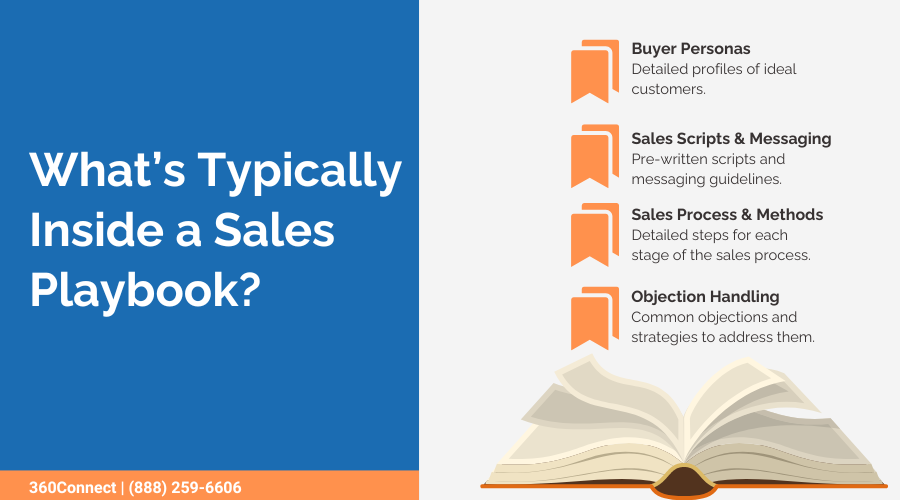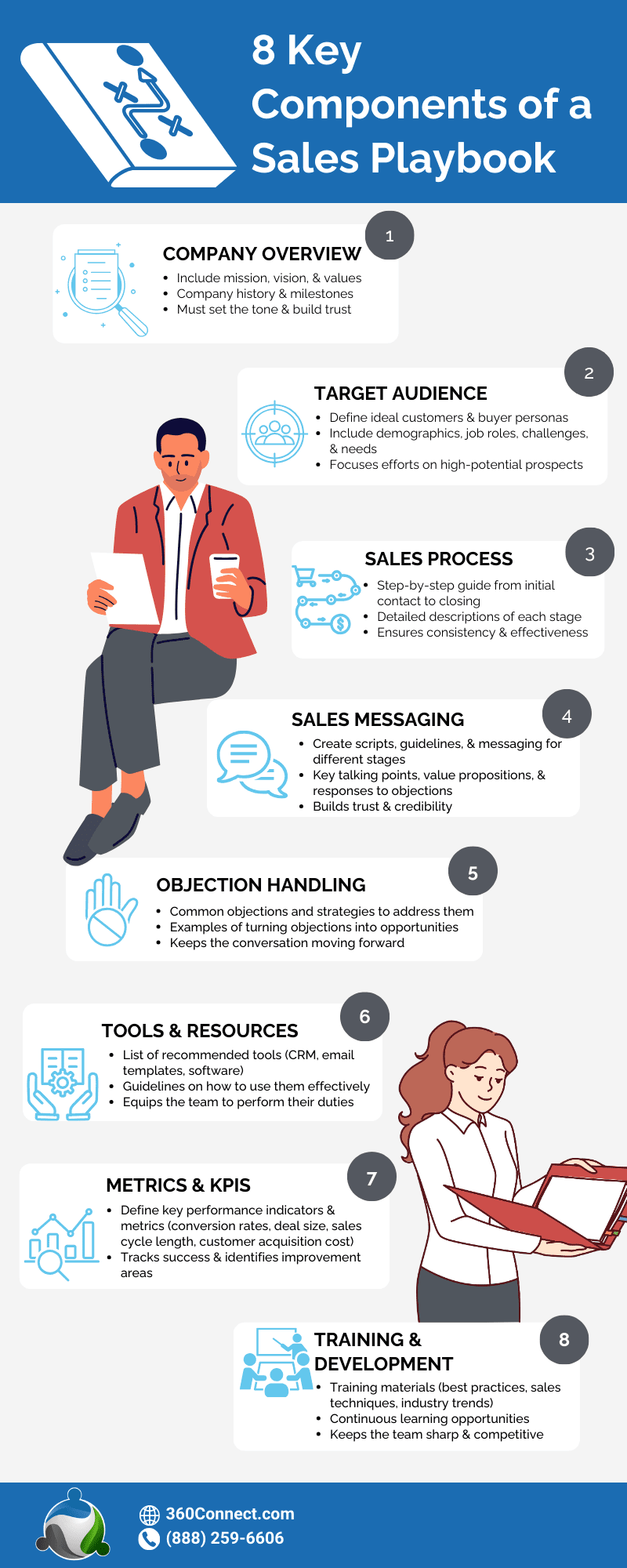If you want your sales team to succeed, you should provide them with the blueprint: a sales playbook.
Sales Playbook. A buzz term you’ve heard thrown left and right, but what exactly is it? And how do you build a successful sales playbook to help your business grow? Well, that’s what we’re here to answer. We want to take the mystery and confusion away from the term and provide you with the information you need to understand the concept and implement it into your sales efforts. So without further ado, let’s jump in.
Already familiar with sales playbooks? Skip to How to Build a Succesful Sales Playbook.
What is a Sales Playbook?
A sales playbook is a guide that embodies your company’s sales process, strategies, and best practices. It is a detailed manual that your sales team can refer to regarding any sales question that may arise from how to approach sales to prospecting and finally closing. Essentially, it is a resource that standardizes the sales approach across the team, ensuring everyone follows the same methods and adheres to the company’s standards and goals.
Here’s how it looks in practice:
- New Hire: How do I go about ____?
- Sales Team Member: Did you check the playbook?
While this is a silly and quick demonstration, that’s the literal purpose of a sales playbook. To efficiently provide your entire team with a guide for sales techniques to streamline the process.
What is Typically in a Sales Playbook?
So, what can you expect to find in a sales playbook? Because it’s a comprehensive resource your sales team can turn to for almost anything, it won’t read as just a list of instructions. Instead, it’s like having a guidebook in the form of a document. You can expect the following four common elements inside:

Buyer Personas
Everyone loves a cheat sheet, and this will be a section your sales representatives will frequently visit. This part of the playbook includes detailed profiles of your ideal customers. Each outline should be specific in terms of demographics, job roles, challenges, etc. This section is a great help to sales representatives to help tailor their approach accordingly.
Sales Scripts and Messaging
This is where you put your messaging and brand guidelines to use. Here, you’ll find pre-written scripts for different stages of the sales process. The scripts help ensure your sales team communicates consistently, effectively, and on brand with the company’s overall tone.
Sales Process and Methods
This section provides a detailed explanation of each step in the sales process. It includes instructions on prospecting, engaging, qualifying, and closing sales. Each step should be outlined in detail to ensure sales representatives know exactly what action to take and when to take them.
Objection Handling
In sales, hearing “no” is part of the job. So, this section provides a list of common objections your team may encounter, along with effective strategies to help turn a no into a conversation that moves forward.
What Type of Document is a Sales Playbook?
A sales playbook can be created in various formats, depending on what works best for your team:
Digital Sales Playbook:
A digital playbook is the best way to make your sales guidelines easily accessible to team members. It can be in the format of an ebook, PowerPoint presentation, PDF, or document stored on a shared drive, just to name a few. Digital playbooks are easy to update and access, making them a flexible option for many organizations.

- Ebook: A comprehensive digital book that can be easily shared and accessed on multiple devices.
- PowerPoint Presentation: Ideal for training sessions and interactive discussions, allowing for visual and engaging content.
- PDF Document: Easy to distribute and print if needed, providing a static but comprehensive resource.
- Web Document: Stored on a shared drive or company portal, making it accessible from anywhere and easy to update.
Physical Sales Playbook:
Some companies prefer having physical copies that can be used during training sessions. Printed manuals allow a sales representative to easily flip through and store in their workspace. However, updating may be difficult and it’s recommended to print in the form of a binder so that updates and changes can easily be made.

- Binder: Ideal for easy updates, as pages can be added or removed as needed.
- Stapled Pages
Overall, no matter the format, the playbook should be easy to access, simple to use, and regularly updated to reflect changes in your sales strategy or market conditions.
Why Do You Need a Sales Playbook?
To put it simply, if you want your sales team to succeed, you need a sales playbook. But to expand on this let’s ask ourselves why we need rules? Why do we need guidelines? The answer is that they provide a clear path to success and help avoid confusion and chaos. The same goes for a sales playbook. It serves as the rulebook for your sales team, ensuring everyone knows exactly what to do and how to do it.
A sales playbook is essential for any sales team aiming for consistency, efficiency, and success.
Here’s why having a sales playbook is crucial:
- Consistency: A playbook ensures each team member learns the same sales methods and delivers consistent messaging and experience to prospects.
- Onboarding: Simplifies training new sales representatives by providing them with all the necessary information.
- Efficiency: Streamlines the sales process by providing clear guidelines and tools, reducing time spent on figuring out what to do next.
- Performance Tracking: A playbook helps make it easier to identify areas for improvement and replicate successful strategies.
In addition, sales teams that use playbooks or a defined sales strategy are 33% more likely to close sales.
Benefits of a Sales Playbook
To piggyback off of why you need a sales playbook, it’s because the benefits are worth it. Implementing a sales playbook offers numerous advantages that can significantly enhance your sales team’s efficiency and overall performance. Take a look at some key benefits:
- Improved Sales Performance: Clear processes and strategies allow your team to focus on selling rather than figuring out the next steps.
- Improved Transition for New Hires: New sales reps can quickly learn the ropes and start contributing to the team’s success.
- Increased Accountability: Clearly defined roles, responsibilities, and metrics hold team members accountable for their performance.
- Better Customer Experience: A standardized approach leads to a more professional and seamless customer experience.
How to Build a Successful Sales Playbook
You know what a sales playbook is, what typically goes into it, the type of formats it comes in, why you need it, and the benefits — now it’s time to build a successful sales playbook!
Building a successful sales playbook requires careful planning and a deep understanding of your sales cycle, customer base, and business objectives. By investing the time and effort into developing a comprehensive playbook, you can ensure that your sales team is well-equipped to achieve their goals and drive your business forward.
Here are the eight key components that should be included in every effective sales playbook:

1. Company Overview
First things first, provide a company overview. The overview sets the stage for your sales playbook by providing your team with a general understanding of your business. It should include your company’s mission, vision, and values. This section should also cover the history of the company and any milestones.
Essentially, the company overview should set a clear tone for the sales team on who they’re representing when making a sale. The knowledge helps salespeople communicate the company’s story effectively and enhances their ability to build trust and credibility. In addition, employees who believe in a company are more likely to succeed with the company.
2. Target Audience
Want a certain prospect? Make it clear in this part of the playbook. Defining your target audience is crucial for your sales team to find the right people. This section should detail your ideal customers and buyer personas. It should include their demographics, job roles, challenges, needs, buying behavior, and more. Basically, this section needs to spell out and clearly showcase who you’re after. If you can’t portray this, then how will your team find this person?
By clearly identifying your target audience, you’re helping your sales team focus their efforts on the prospects most likely to convert.
3. Sales Process
This is the step-by-step guide that will ensure a smooth sales system. In this part of the sales playbook, you will need to outline what procedures should be followed from initial contact to closing the deal. It should include detailed descriptions of each stage in the funnel (prospecting, qualifying, closing). A clear guide helps ensure consistency and effectiveness from all team members.
Providing a structured sales process helps your team understand and visualize what needs to be done throughout the sales process, and how to move a lead through the sales funnel.
Related: How to Create a B2B Sales Plan
4. Sales Messaging
Your brand has a voice, and each sales member needs to follow it. Sales messaging is a critical component of your sales playbook. In this section of the playbook, provide scripts, guidelines, and messaging for different stages of the sales process. For example, you don’t want your sales agents talking to a buyer in the awareness and consideration stage the same. In addition, your sales messaging section should include key talking points, value propositions, and responses to common questions or objections.
Having a clear and consistent sales message is essential for building trust and credibility with your audience.
5. Objection Handling
In sales, hearing the word “no” is normal. But turning a no into a yes is also part of the job. When it comes to objection, you want your sales agents to be ready with the proper way to handle it to save the sale. This section of the sales playbook should include examples of how to turn objections into opportunities and keep the conversation moving forward.
Objection handling is a critical skill for any sales professional. By providing your team with ready-to-use responses to common objections, you’re helping them quickly address concerns and move the conversation toward closing the deal.
6. Tools & Resources
This section should detail the tools and resources available to your sales team. Providing a list of recommended tools, along with guidelines on how to use them effectively, ensures that your team is well-equipped to perform their duties.
- CRM
- Email Templates
- Software
- And More
7. Metrics and KPIs
If you’re looking for specific sales results, put your key objectives in your sales playbook. Defining the key performance indicators (KPIs) and metrics your team should track is essential for measuring success.
This section should outline the specific metrics that will be used to evaluate the performance of your sales team, such as conversion rates, average deal size, sales cycle length, and customer acquisition cost. Clear definitions of these metrics and how they are calculated are crucial.
Regularly reviewing these metrics helps keep your sales team accountable and focused on the activities that drive results.
8. Training and Development
Continuous training and development are vital for maintaining a high-performing sales team. This section should include training materials like best practices, sales techniques, industry trends, and more. Providing opportunities for continuous learning helps your team stay sharp and competitive.
Creating a Sales Playbook for YOUR Business
Now that you know the components necessary for a successful sales playbook, you’ll need to optimize it for YOUR business. Here are a few tips to ensure your playbook isn’t too general and resonates with your sales team.
3 Tips to Create a Sales Playbook for Your Team
1. Collaborate with Your Team
A great way to make a sales playbook embody your business is to get input from those who make it what it is: your sales team. Involving your sales team in the creation of the playbook can significantly increase its effectiveness and their likelihood of adopting it. Your team members are the ones on the front lines, so their insights and feedback are invaluable.
- Gather input from top performers
- Create an inclusive feedback process
- Pilot and test suggestions
2. Keep it Simple
Yes, we just said to make the sales playbook your own, but we want to highlight that sometimes less is more. A sales playbook should be comprehensive but not overwhelming. Keeping it simple and straightforward helps ensure your team can easily understand and use it.
- Clear content
- Visual aids
- User-friendly formatting
3. Continuously Improve
A sales playbook is a living document that should evolve with your business. Regular updates and continuous improvement are essential to keep it relevant and effective.
- Schedule regular reviews and updates
- Implement a feedback process
- Track performance metrics
How to Implement and Maintain a Sales Playbook
Congratulations, you have all that you need to create a comprehensive sales playbook! The next step is to effectively implement and maintain it within your organization. Here are a few helpful suggestions:
- Rollout Strategy: We suggest you develop a rollout strategy before introducing the playbook to your team. This might involve scheduling training sessions, workshops, or team meetings to present the playbook and explain its importance.
- Training Sessions: Conduct detailed training sessions to ensure every team member understands how to use the playbook. Walk them through each section, explaining how to apply the guidelines and strategies in their daily activities. Use interactive methods such as role-playing, group discussions, and Q&A sessions to make the training more engaging and effective.
With these suggestions, you can ensure that your sales playbook is effectively implemented and maintained, becoming a vital tool that drives consistency, efficiency, and success within your sales team.
Final Thoughts
Creating a sales playbook isn’t easy, but with the tips and strategies we’ve provided, we hope it can help you build a successful guide for your sales team.
Investing the time and effort into developing a detailed sales playbook means setting your sales team up for long-term success. We wish you the best, and with a solid playbook in hand, your sales team will be well-prepared to tackle any challenge and close more deals.
Looking to Improve Your Sales?
Are you looking to boost your sales and connect with quality leads? At 360Connect, we are focused on YOUR success and provide you with quality leads and support to help grow your business. Join 360Connect’s supplier network and connect with verified, high-quality leads today!

